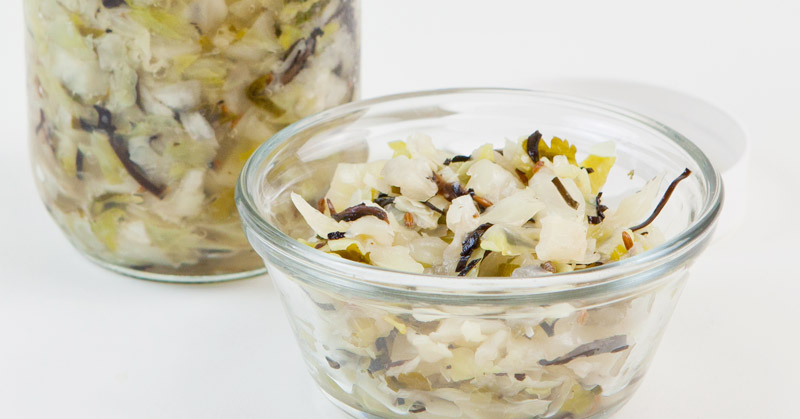Yesterday’s recipe was for homemade cream cheese with a handy by-product of whey. Today, I’m going to use some of that whey we made in another one of my all-time favorites: homemade sauerkraut.
(Another big thank you to Sally Fallon and her fantastic cookbook Nourishing Traditions: The cookbook that challenges politically correct nutrition and the diet dictocrats for this recipe and introducing me to the idea of lacto-fermentation to begin with.)
You can buy sauerkraut from the store, but often it’s made with vinegar, too much salt, and the vegetables are pasteurized, which reduces their nutritional value. This homemade sauerkraut is a type of raw cultured vegetable – a whole different creature.
Raw cultured vegetables – also known as lacto-fermented vegetables – are vegetables preserved through a process of lacto-fermentation. Lactic acid is a natural preservative that inhibits putrefying bacteria. Starches and sugars in vegetables and fruits are converted into lactic acid by many species of lactic-acid-producing bacteria, or “lactobacilli”. Numerous important chemical changes take place during this type of fermentation, far beyond their practical purpose of preservation.
- Cultured veggies are already partially digested, so they’re easy on the system. Not only are they readily absorbed by your body, they enhance your body’s ability to digest and absorb nutrients from the other things you eat at the same time.
- They’re delicious, and add a unique flavor to your meals.
- They help to balance the pH of your digestive tract.
- They offset the toxic and carcinogenic effects of the charcoal from BBQ.
- They are naturally packed with digestive enzymes and probiotics, which support the health of your digestive system.
- They help to heal the lining of your intestines by promoting the growth of healthy flora.
- They promote a healthy and strong immune system.
- And last but certainly not least, they help reduce sugar cravings.
I could go on, but you get the picture. Many traditional cultures have preserved veggies and fruits using this method. The most commonly known is the European version: sauerkraut, or lacto-fermented cabbage. Here’s how you make it.
Equipment you’ll need:
- Big bowl
- Meat hammer, wooden pounder or a pestle (or you can get this incredible sauerkraut kit, which I absolutely love)
- Quart-sized mason jar
Ingredients:
- 1 medium cabbage, cored and shredded
- 1 tbsp caraway seeds
- 1 tbsp sea salt
- 4 tbsp whey (see whey recipe from yesterday’s posting)
In bowl, mix the cabbage with caraway seeds, sea salt and whey. Pound the mixture with the hammer, pounder or pestle (my personal favorite) for about 10 minutes to release juices. Place in a quart-sized, wide-mouth mason jar and press down firmly with a pounder or meat hammer until juices come to the top of the cabbage. The top of the cabbage should be at least 1 inch below the top of the jar. Cover tightly and keep at room temperature for about 3 days before transferring to cold storage. It keeps for months. The sauerkraut may be eaten immediately, but it improves with age.




Trackbacks/Pingbacks